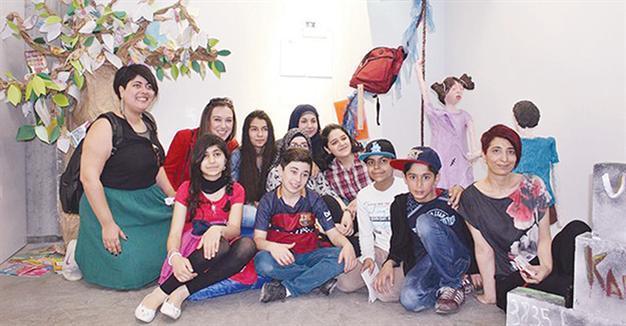Syrian children underline hardships of living in Turkey through art
ISTANBUL – Doğan News Agency

Syrian children in Turkey marked the 4th Istanbul Children and Youth Arts Biennial with their projects encompassing issues facing them, such as the “right to education” and “secure living conditions,” during various art and music projects of the Association for Solidarity with Asylum Seekers and Migrants (ASAM).
The children, who attended the biennial’s opening on April 19, created three pieces, including a road installation project meant to represent their mass displacement from Syria. The road installation was made up of faces children made by using wires, fabric, string and other materials. The project also related to the theme of this year’s biennial, “Wake up call.”
Creators of the second project, “Let’s Wake up to Rights and Awareness” aimed to reflect the fundamental problems that refugee children face including the “difficulty to access the right to education” and “adequate living conditions.” The piece was made up of multiple components, including a kite decorated with school materials such as books and schoolbags, and a boy and a girl holding the kite.
Artist Meryem Tomak who coordinated the project said the projects had had hugely positive effects on the children, whose ages range between 8 and 16. Participants of the art and video workshops worked hard to prepare their own pieces, she said. Many of these children share their heavy experiences, along with their enthusiasm for art and music, with friends at school, Tomak added.
The Syrian children were certain to make sure that their project “Let’s Wake up to Rights and Awareness” referred to children all over the world who have been deprived of the right to education and forced to be child brides or workers.
Menar, a 16-year-old who fled Damascus and came to Turkey two years ago, helped come up with the idea of the kite installation. The figures holding a kite, which represents children’s right to education, symbolize two issues blocking children from education: child marriage and child labor.
She explained how the idea came up, saying “These are the handicaps that we face. After all, we have come from a war, and our biggest problem is education.”
According to Menar, another significant problem of Syria refugee children and youth in Turkey is “trust.” Menar thinks “people in Turkey do not like Syrians nor [do they] trust them.”
Another creator of the work, 12-year-old Roz, came Hasakah two years ago. Her favorite social activity is “painting, painting and painting,” taking after her father who also paints. Roz said she wanted to go back to her home country of Syria.
In addition to her struggles to go outside to play games, Roz added that she cannot understand her Turkish lectures. “When I do not understand the courses, I draw,” she said.
The sculpture shows a boy and his older sister holding hands after fleeing war in Syria, Roz said. According to the young girl, the paintings on the kite represent “buildings demolished” while the green colors and trees represent the “right to play.”
“No school, no permit to work. Some of my friends’ fathers do not let them to go to school. I have friends who work, while some others are forced into marriage,” she said.
A hip-hop project The third project undertaken by other Syrian children was a hip-hop music project called “I woke up in a Foreign Country,” which was run with the help of the music group “Tahribad-ı İsyan.”
A record playing in the biennial’s video-art section is based on lyrics written by these children. The aim of the project was to emphasize “the universal language of music and dance” through the “protest stance of hip-hop” to bring awareness for the rights of Syrian refugees and other children. The project reflects on “the universality of the effects of war,” said the group.
Language is the key to communication, explained the children, pointing out that their biggest difficulties stem from not speaking Turkish.
Juwan, who is a 13-year-old boy wearing a hip-hop-style hat, said he likes going to school and enjoys math classes the most. “I like playing football with my friends. There is a football pitch in Kasımpaşa” he said, referring to an Istanbul neighborhood within the city’s Beyoğlu district.
A friend of Juwan who also plays football, 12-year-old Fawzi, is from Aleppo. Fawzi has a sister, his mother does not work and he cannot say what his father does to earn the family’s bread. According to Fawzi, the exhibit’s road installation represents his own family’s journey from Syria.
Syrian children explained that the dissimilar emotions expressed on the faces made from wires represent their different feelings about their current home and respective journeys. “It is because some of us came here unhappy, while some of us came with joy.”
The exhibition of ASAM, which displays art and video works of Syrian children produced during social activities in cooperation with United Nations Refugee Agency (UNHCR), can be visited at Istanbul Modern’s Antrepo until May 22.
 Syrian children in Turkey marked the 4th Istanbul Children and Youth Arts Biennial with their projects encompassing issues facing them, such as the “right to education” and “secure living conditions,” during various art and music projects of the Association for Solidarity with Asylum Seekers and Migrants (ASAM).
Syrian children in Turkey marked the 4th Istanbul Children and Youth Arts Biennial with their projects encompassing issues facing them, such as the “right to education” and “secure living conditions,” during various art and music projects of the Association for Solidarity with Asylum Seekers and Migrants (ASAM).